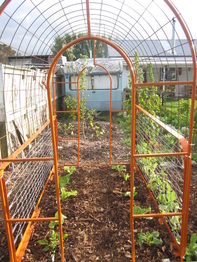
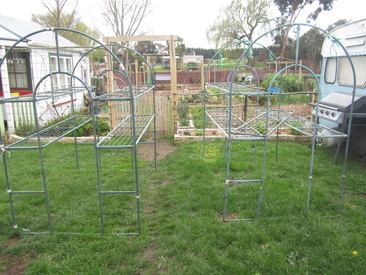
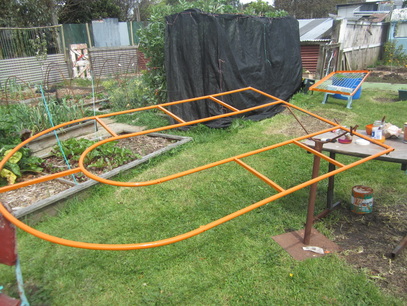
In between coats of paint, I prepared the bed where my trellis was to go – after harvesting the previous crops, I forked over the soil, then added 3 bags of compost, a wheelbarrow load of manure, and a couple of catchers full of grass clippings and stirred it all in. I raked it level, and then added wood chip mulch, and created paths for walking down both sides by digging out the soil forming a trench, which was filled with more woodchip and stomped gently down.
Once the paint was dry, I moved each piece to the garden bed, and assembled it on-site. The pieces are held together with cable ties – that proved to make it relatively easy to put together, and it will be easy to take apart in the future if I need or want to, yet the whole structure is very rigid and sturdy. Cable ties were first put loosely in each corner, top and bottom, and then everything was leveled out and adjusted before tightening them up.
Next came the fun part – adding the reinforcing mesh for the upper curved trellis. Fortunately, a single bed is the same length as the width of a sheet of mesh, but the sheets are 4.6m long. I managed to get one home from the building supply store by tying it down to the roof of my van. :-) Now, I measured the length of the curve, cut the 2.8m of mesh needed, and got ready to lift it into position. Knowing it would involve a bit of sliding the mesh around, and not wanting to damage the new paint on the frames, I first found a couple of long cardboard tubes from inside rolls of weed mat, and cut a slit down the length of each, and then used them to slide onto the top arch of the frame for protection. These were removed after I had the mesh secured in place. The mesh was lifted up (this part was the only time where I required help from a second person, to lift one side, then hold it while I bent the mesh into position). I used cable ties along both sides to hold the mesh to the top of the bed frames (which have convenient holes where the springs go through the frames) and then at the top and sides of the arch.
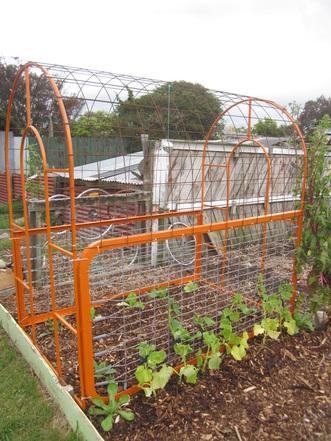
Along one side I planted 3 each of Lemon Cucumbers and Apple Cucumbers, which have been hardening off outside after I raised them from seed in my greenhouse. I added a self-sown calendula seedling from elsewhere in my garden to each end of the row, as it’s good to have orange or yellow flowers close to the cucumbers to attract bees close enough to spot the fairly inconspicuous cucumber flowers. This is also why I chose orange for the paint – hopefully it will be like a signpost to the bees – “Hey bees, good stuff over here! Come check it out!” A couple of handfulls of sheep pellets were put in the bottom of each cucumber planting hole.
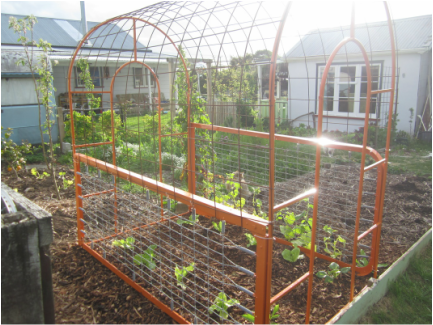
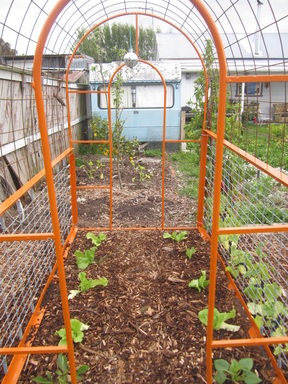
I also added a ball covered in mirror squares, dangling on a string from the top, as a bird scarer. After watering the seedlings, I sprinkled slug pellets around to keep the slugs and snails from devouring my lovely wee plants!
This was a really fun project to make – and it only cost a total of $23 – $20 for half a sheet of mesh, $1 for my bird scarer/disco ball, and $2 for the cable ties. The beds, frames and paint were free, and the only tools needed were a paintbrush plus measuring tape and bolt cutters to cut the mesh.
I can’t wait to see all the plants grown up over it!
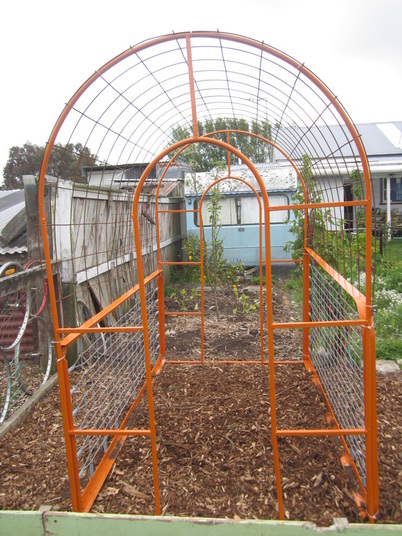
 RSS Feed
RSS Feed
